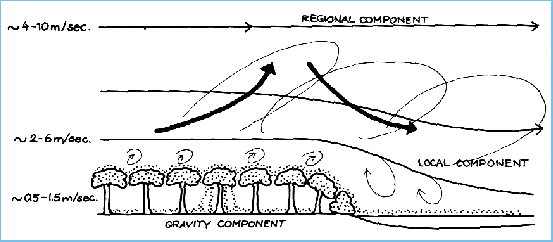D I S P E R S I O N
Wind Pollination

Normal wind conditions (lines), pollen transportation and deposition (dots) in a forest and a lake. Thin lines: horizontal wind and turbulence; heavy lines: resultant updraft
Wind pollination, or anemophily, is the random dispersal of pollen in the atmosphere using wind currents. Plants using this mechanism will produce a great quantity of grains due to the chance factor involved in the meeting of the two gametophytes. A small fraction of this pollen will settle on the stigmata of other plants, but the bulk of it will be lost in lakes and bogs. Therefore, pollen of anemophilous species will be well represented in the fossil record. For this reason, palynologists find this type of pollen more useful to make paleoenvironment reconstructions and other studies, as shall be discussed in the next section.
|
|
|